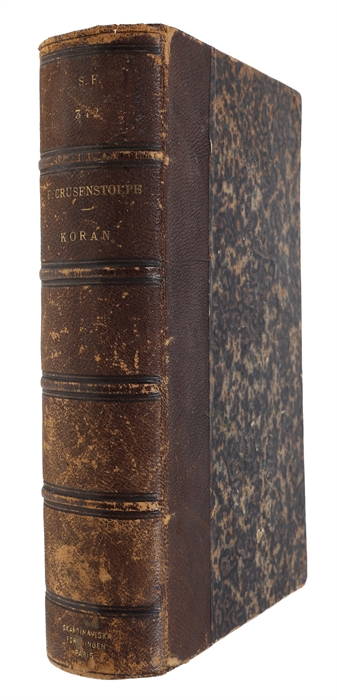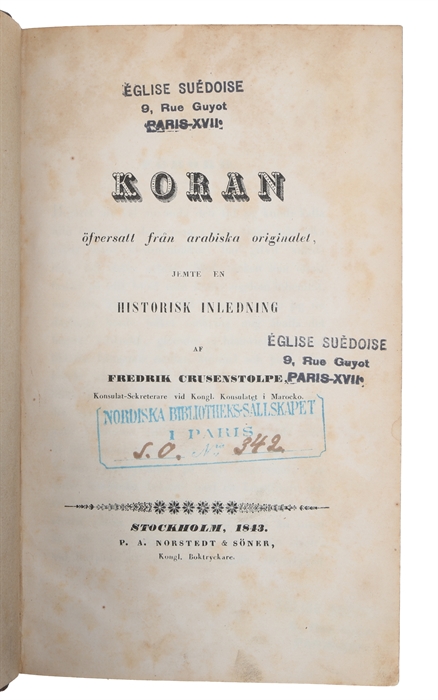FIRST COMPLETE TRANSLATION OF THE QURAN IN ANY SCANDINAVIAN LANGUANGE
QURAN -
Koran öfversatt från arabiska originalet, jemte en historisk inledning af Fredrik Crusenstolpe, konsulat-sekreterare vid kongl. konsulatet i Marocko.
Stockholm, Nordstedt & Söner, 1843.
8vo. In contemporary half calf with four raised bands. Wear to extremities, spine with scratches. Stamps (From Nordiska Bibliotheks-Sallskapet in paris. With an accompanying "deaccession"-note from the librarian Leif stating many doublets and unused book were sold, including the present) l to front free end-papers, title-page and last two leaves. With light occassional brownspotting throughout. V, (1), 783, (1), 26, (1) pp.
The rare first complete Swedish translation of the Quran – also being the first translation in any Scandinavian language. “Between 1843 and 1967, four translations of the Quran were published in Scandinavia: three in Sweden, and one in Denmark. Prior to and during this period, theologians and philologists at Scandinavian universities had studied the Quran as part of their training in the Arabic language, and had translated parts of the text, first into Latin and then into the respective national languages. The first three Scandinavian translations of the Quran were into Swedish. The first of these translations, published in 1843, was done by Johan Fredrik Sebastian Crusenstolpe (1801– 1882). This was followed by the translation made by theologian and professor of Arabic literature, Carl Johannes Tornberg (1807– 1877) in 1874, and the one by Karl Vilhelm Zetterst (1866– 1953), a prominent Swedish professor of Semitic languages, which was published in 1917. Zetterst's translation has been republished several times and is still in use. In Danish, it was not until 1967 that a full translation of the Quran was published, by teacher Abdus Salam (Svend Åge) Madsen (1928– 2007), and in Norway it took another decade and a half before the first translation was published, by university lecturer Einar Berg (1921– 1995) in 1980.” (Eggen, On the Periphery, Translations of the Quran in Sweden, Denmark and Norway) Fredrik Crusenstolpe, a Swedish officer and diplomat, was known for his adventurous spirit and eccentricity. Crusenstolpe served in Tripoli, Tangier, Algiers and Lisbon. His translation emerged during a period of growing interest in the Middle East and North Africa among Scandinavia's cultural elite in the late 18th and early 19th centuries. While stationed in North Africa, Crusenstolpe developed a deep interest in the local people and their religion. However, securing financial support for the publication of his translation was challenging despite interest from a prominent publishing house. He ended up financing the project privately especially motivated by a personal desire to correct misconceptions about Prophet Muhammad in Swedish popular culture. To Crusenstolpe these misconceptions reflected not just ignorance about the Prophet but also a broader superstitious mentality he did not like. He portrayed the Muhammed as a rational "Arabic founder of law" aligning with Enlightenment-era European depictions of Muhammad. OCLC lists only four copies (Library of Congress, NY Public Library, Ohio State University & Cleveland Public Library).
Order-nr.: 61664



